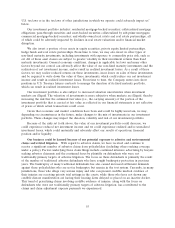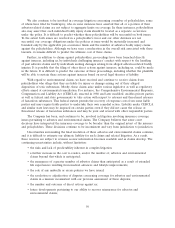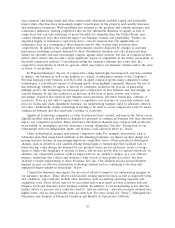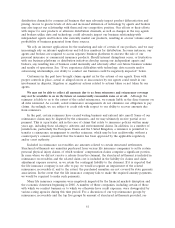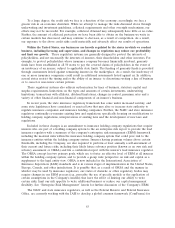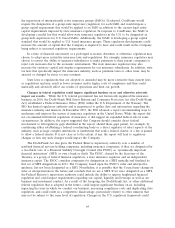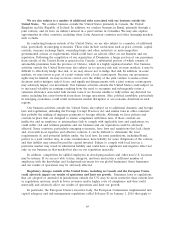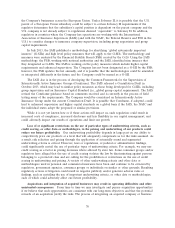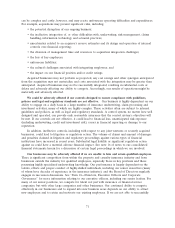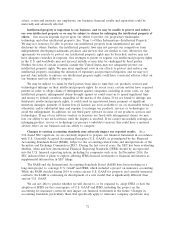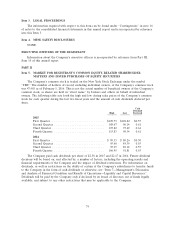Travelers 2015 Annual Report Download - page 64
Download and view the complete annual report
Please find page 64 of the 2015 Travelers annual report below. You can navigate through the pages in the report by either clicking on the pages listed below, or by using the keyword search tool below to find specific information within the annual report.the supervision of internationally active insurance groups (IAIGs). If adopted, ComFrame would
require the designation of a group-wide supervisor (regulator) for each IAIG and would impose a
group capital requirement that would be applied to an IAIG in addition to the current legal entity
capital requirements imposed by state insurance regulators. In response to ComFrame, the NAIC is
developing a model law that would allow state insurance regulators in the U.S. to be designated as
group-wide supervisors for U.S. based IAIGs. Additionally, the NAIC is developing a group capital
standard that would be applied to U.S. based insurance groups. These regulatory developments could
increase the amount of capital that the Company is required to have and could result in the Company
being subject to increased regulatory requirements.
In a time of financial uncertainty or a prolonged economic downturn or otherwise, regulators may
choose to adopt more restrictive insurance laws and regulations. For example, insurance regulators may
choose to restrict the ability of insurance subsidiaries to make payments to their parent companies or
reject rate increases due to the economic environment. The state insurance regulators may also
increase the statutory capital and surplus requirements for our insurance subsidiaries. In addition, state
tax laws that specifically impact the insurance industry, such as premium taxes or other taxes, may be
enacted or changed by states to raise revenues.
State laws or regulations that are adopted or amended may be more restrictive than current laws
or regulations and may result in lower revenues and/or higher costs of compliance and thus could
materially and adversely affect our results of operations and limit our growth.
Changes in federal regulation could impose significant burdens on us and otherwise adversely
impact our results. While the U.S. federal government has not historically regulated the insurance
business, in 2010, the Dodd-Frank Wall Street Reform and Consumer Protection Act (the Dodd-Frank
Act) established a Federal Insurance Office (FIO) within the U.S. Department of the Treasury. The
FIO has limited regulatory authority and is empowered to gather data and information regarding the
insurance industry and insurers. In December 2013, the FIO released a report recommending ways to
modernize and improve the system of insurance regulation in the United States. While the report did
not recommend full federal regulation of insurance, it did suggest an expanded federal role in some
circumstances. In addition, the report suggested that Congress should consider direct federal
involvement to fill regulatory gaps identified in the report, should those gaps persist, for example, by
considering either establishing a federal coordinating body or a direct regulator of select aspects of the
industry, such as large complex institutions or institutions that seek a federal charter, if a law is passed
to allow a federal charter. It is not clear as to the extent, if any, the report will lead to regulatory
changes or how any such changes would impact the Company.
The Dodd-Frank Act also gives the Federal Reserve supervisory authority over a number of
nonbank financial services holding companies, including insurance companies, if they are designated by
a two-thirds vote of a Financial Stability Oversight Council (the FSOC) as ‘‘systemically important
financial institutions’’ (SIFI) or own a bank or thrift. The FSOC, chaired by the Secretary of the
Treasury, is a group of federal financial regulators, a state insurance regulator and an independent
insurance expert. The FSOC considers companies for designation as a SIFI annually and finalized its
first set of SIFI designations in 2013. The Company, based upon the FSOC’s rules and interpretive
guidance, has not been designated as a SIFI. Nonetheless, it is possible that the Council may change its
rules or interpretations in the future and conclude that we are a SIFI. If we were designated as a SIFI,
the Federal Reserve’s supervisory authority could include the ability to impose heightened financial
regulation and could impact requirements regarding our capital, liquidity and leverage as well as our
business and investment conduct. As a result of the foregoing, the Dodd-Frank Act, or other additional
federal regulation that is adopted in the future, could impose significant burdens on us, including
impacting the ways in which we conduct our business, increasing compliance costs and duplicating state
regulation, and could result in a competitive disadvantage, particularly relative to other insurers that
may not be subject to the same level of regulation. Changes in the U.S. regulatory framework could
64



